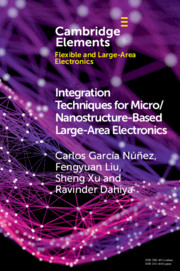Integration Techniques for Micro/Nanostructure-based Large-Area Electronics
Published online by Cambridge University Press:
01 November 2018
- Carlos García Núñez
- Affiliation:
University of Glasgow
- Fengyuan Liu
- Affiliation:
University of Glasgow
- Sheng Xu
- Affiliation:
University of California, San Diego
- Ravinder Dahiya
- Affiliation:
University of Glasgow
Summary
Advanced nanostructured materials such as organic and inorganic micro/nanostructures are excellent building blocks for electronics, optoelectronics, sensing, and photovoltaics because of their high-crystallinity, long aspect-ratio, high surface-to-volume ratio, and low dimensionality. However, their assembly over large areas and integration in functional circuits are a matter of intensive investigation. This Element provides detailed description of various technologies to realize micro/nanostructures based large-area electronics (LAE) devices on rigid or flexible/stretchable substrates. The first section of this Element provides an introduction to the state-of-the-art integration techniques used to fabricate LAE devices based on different kind of micro/nanostructures. The second section describes inorganic and organic micro/nanostructures, including most common and promising synthesis procedures. In the third section,different techniques are explained that have great potential for integration of micro/nanostructures over large areas. Finally, the fourth section summarizes important remarks about LAE devices based on micro/nanostructures, and future directions.



